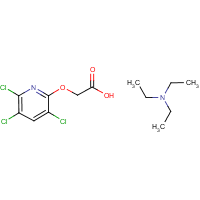Triclopyr-triethylammonium
Agent Name
Triclopyr-triethylammonium
Alternative Name
Triclopyr TEA
CAS Number
57213-69-1
Formula
C7-H4-Cl3-N-O3.C6-H15-N
Major Category
Pesticides

Synonyms
Triclopyr TEA; ((3,5,6-Trichloro-2-pyridinyl)oxy)acetic acid compd. with N,N-diethylethanamine (1:1); (3,5,6-Trichloro-2-pyridinyl)oxyacetic acid, triethylamine salt; Garlon 3A; M 3724; N,N-Diethylethanamine compd. with ((3,5,6-trichloro-2-pyridinyl)oxy)acetic acid (1:1); Triclopyr triethylamine; Triclopyr triethylamine salt; ((3,5,6-Trichloro-2-pyridyl)oxy)acetic acid, compound with triethylamine (1:1); Acetic acid, ((3,5,6-trichloro-2-pyridinyl)oxy)-, compd. with N,N-diethylethanamine (1:1); Triclopyr triethylammonium salt; Triethylammonium triclopyr; [ChemIDplus] Grandstand; [Merck Index]
Category
Herbicides, Other
Description
Colorless to amber liquid; [CAMEO] Grayish-white solid; Formulated as soluble and emulsifiable concentrates, liquid, granular, formulation intermediate, wettable powder, and pellets; [Reference #1]
Sources/Uses
Used as systemic herbicide for control of broad-leaved weeds and woody plants in rice, range and pastureland, rights-of-way, forestry, and turf (including residential lawns and gardens); [Reference #1]
Comments
Hepatotoxic, skin sensitizer, and corrosive to eyes in animal studies; [Reference #1] See "Triclopyr."
Reference Link #1
Biomedical References
Exposure Assessment
Lethal Concentration
LC50 (rat) > 2,600 mg/m3
Adverse Effects
Skin Sensitizer
Yes
Hepatotoxin
Hepatoxic (a) from occupational exposure (secondary effect) or (b) in animal studies or in humans after ingestion
Diseases, Processes, and Activities Linked to This Agent
Diseases
Occupational diseases associated with exposure to this agent:
Processes
Industrial Processes with risk of exposure: